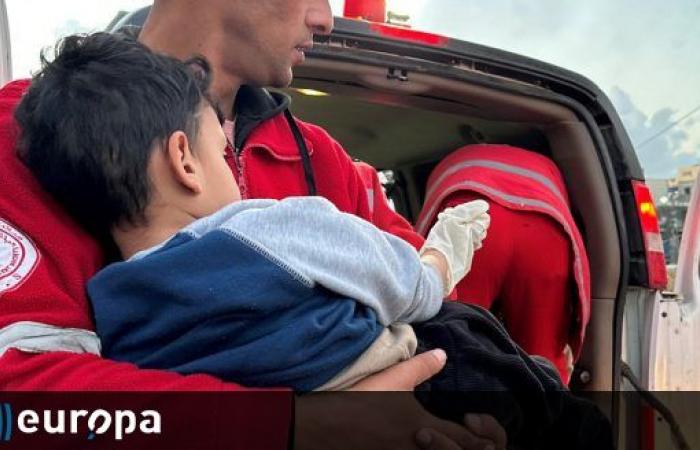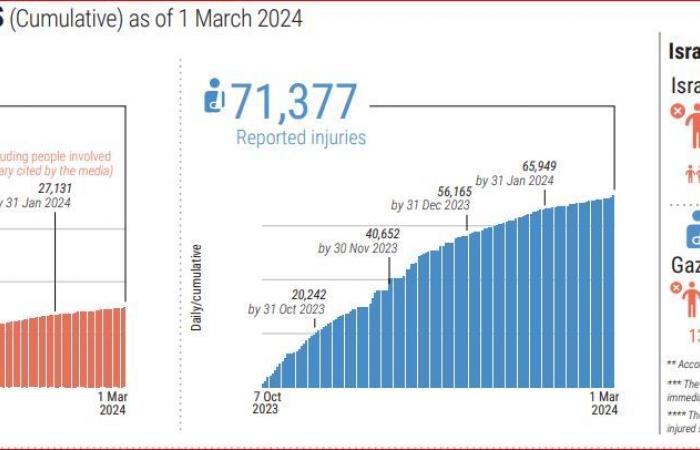On March 1, 2024, intense Israeli air, land and sea bombardment continued to be reported on most of the Palestinian territory of the Gaza Strip. Bombings that resulted in more civilian casualties, forced displacement of the population and destruction of civilian infrastructure. Ground operations and intense fighting between Israeli forces and Palestinian Hamas armed groups also continued to be reported.
Between the afternoon of February 29th and 12:30 pm on March 1st, data from the Gaza Ministry of Health indicate that 193 Palestinians were killed and 920 Palestinians were injured. With these new victims, the numbers between October 7, 2023 and 12:30 pm on March 1, 2024, rise to at least 30,228 Palestinians killed in Gaza and 71,377 Palestinians injured.
On March 1, UN Secretary-General António Guterres declared: “I am appalled by the tragic human cost of the conflict in Gaza – more than 30,000 people reportedly killed and more than 70,000 injured. I reiterate my call for an immediate humanitarian ceasefire and the unconditional release of all hostages.”
As reported, the Ministry of Health in Gaza indicated that the number of victims of the incident on Rashid Street, south of Gaza City, on February 29, increased to 112 dead and 760 injured. An incident that has already led several countries to call for an independent investigation into the circumstances that led to the death and injuries of Palestinians while they were awaiting humanitarian aid.
The UN Secretary-General stated that “desperate civilians in Gaza need urgent help, including those in the besieged north, where the United Nations has been unable to deliver aid for more than a week.”
Among other deadly incidents reported on February 28 are the following:
■ On February 28, at around 4:45 pm, 14 Palestinians were killed and dozens of others injured, when four buildings in the An Nuseirat Refugee Camp, in Deir al Balah, were hit.
■ On February 28, at around 7 pm, nine Palestinians were killed and dozens of others injured, when a house in An Nuseirat, in Deir al Balah, was hit.
■ By midnight on February 28, 18 bodies were said to have been recovered from the rubble at An Nuseirat in Deir al Balah.
■ At midnight on February 28, 14 bodies were reportedly recovered from the rubble at Khan Younis.
■ On February 28, at around 6 pm, four Palestinians were killed and others were injured, when a house in Al Bureij, in Deir al Balah, was hit.
Between the afternoons of February 29 and March 1, there were no reports of Israeli soldiers killed in Gaza. Thus, data from the Israeli military indicates that by March 1, it remains that 240 soldiers will have been killed and 1,432 soldiers will have been injured in Gaza since the start of the ground operation.
The Ministry of Health in Gaza reported again that 10 more children had died as a result of malnutrition and dehydration, including four at Kamal Adwan Hospital in northern Gaza on 29 February.
On February 27, Save the Children warned that Gaza is witnessing “a mass murder of children in slow motion because there is no food and nothing reaches them.” For some time now, warnings from UNICEF and the World Health Organization (WHO) about the threat of malnutrition among children have echoed.
On February 29, the Secretary General of the Norwegian Refugee Council, Jan Egeland, reported witnessing “the children of Gaza, visibly malnourished, reduced to searching the streets for food and assistance. It is unimaginable that an entire population is left to starve while large quantities of supplies are waiting just a few kilometers away, on the other side of the border.
“The Secretary General of the Norwegian Refugee Council has called on all states supporting parties to the conflict to “insist on a ceasefire and full humanitarian access and aid provision. The human suffering in Gaza is already unbelievable and this war against civilians must end immediately.”
On 29 February, the Union of Municipalities of the Gaza Strip called for the immediate entry of fuel into Gaza City and northern Gaza governorates, to enable municipalities to provide basic services, including water, wastewater treatment and collection and transfer. of solid waste. None of the provinces have received fuel since the end of October 2023, which has been exacerbated by the electricity cut, which has led to a significant gap in service delivery and water shortages, as well as waste accumulation and sewage overflow .
Appeals come from the most varied data from humanitarian organizations for the provision of medium and heavy machinery and backup generators to replace destroyed equipment.
According to the organization CARE, an analysis of satellite imagery reveals that cities in the Gaza Strip have seen a huge decrease in electricity, with nighttime light reduced by 84 percent, and Gaza City has seen the largest reduction, at 91 percent. Percent. The analysis found that 70 percent of hospitals had little or no night lights, with power cuts being particularly severe in Gaza City and North Gaza. “Energy means life or death in hospitals. We hear about newborns dying because there is no electricity for the incubators; children stop breathing and mothers die on the operating table simply because the life-saving machine was turned off”, said the Director of the CARE organization.








